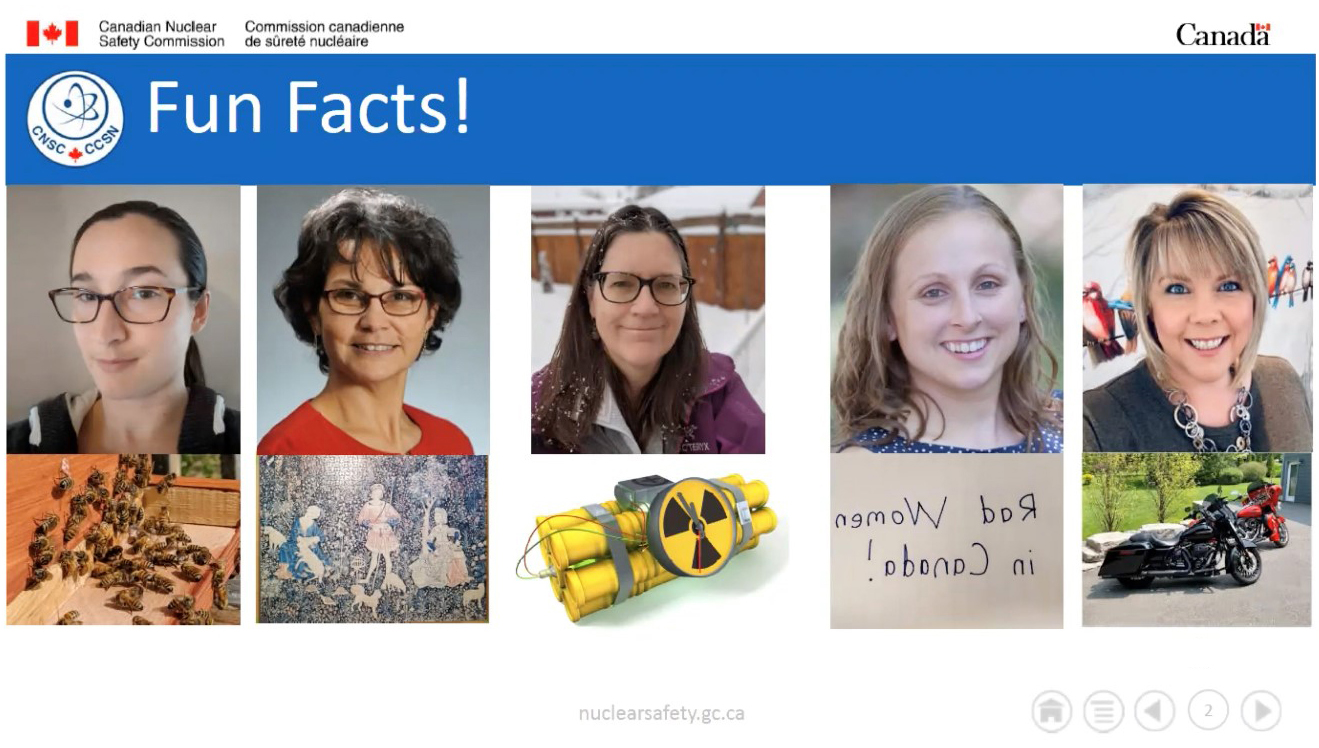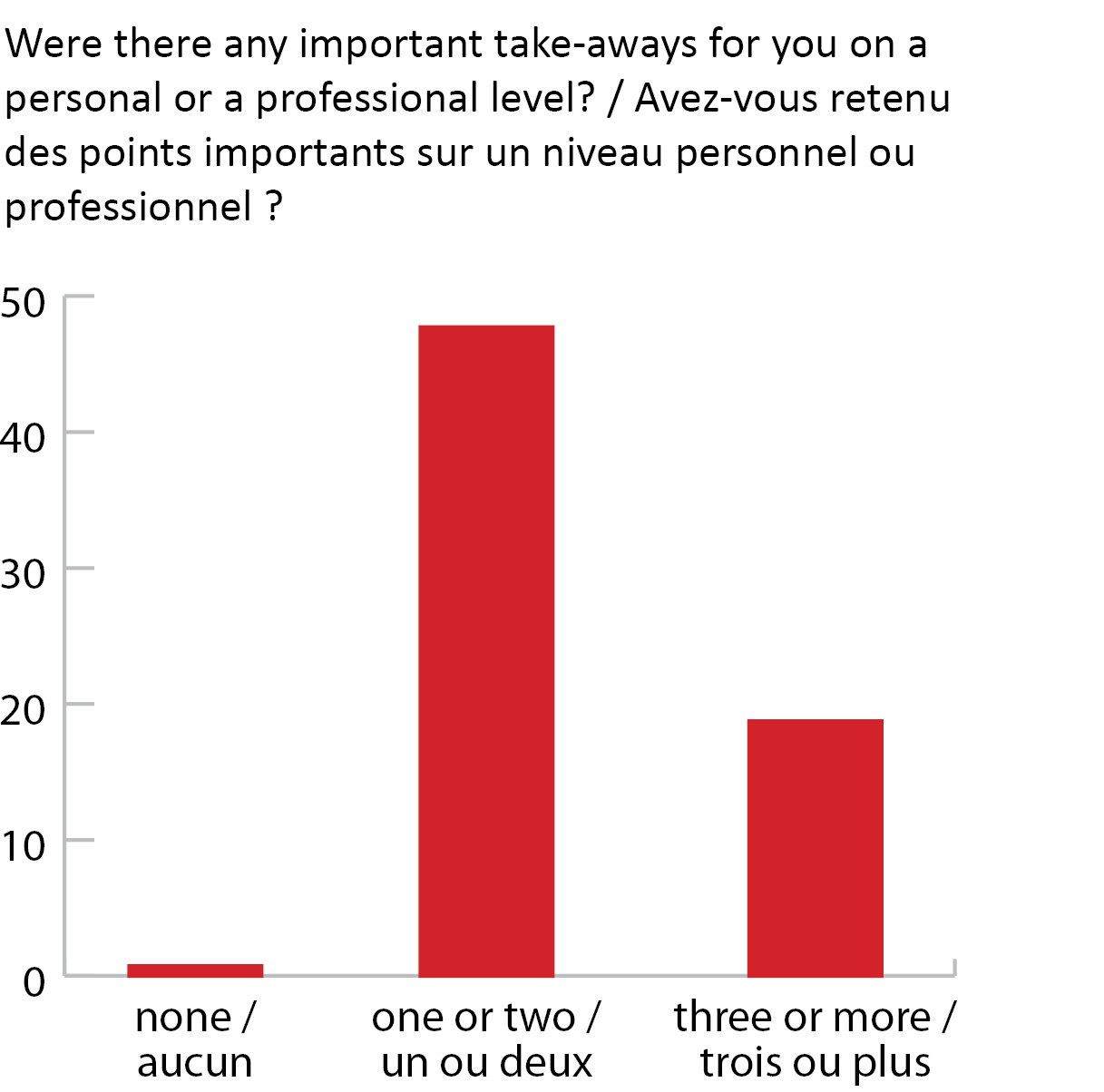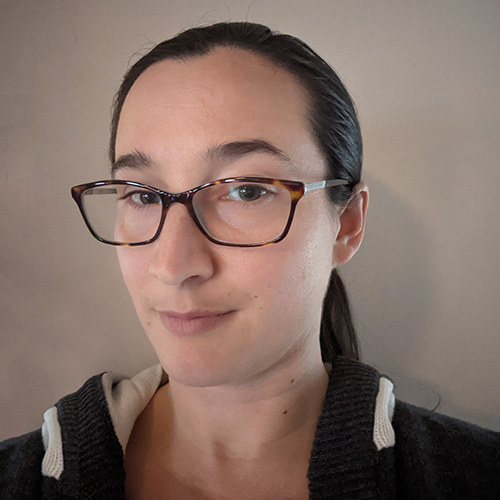Femmes et rayonnement au Canada

Les experts (de gauche à droite) : Julie Leblanc (conseillère spéciale de FESTIM, CCSN), Haidy Tadros (directrice générale, Direction de l’évaluation et de la protection environnementales et radiologiques, CCSN), Debora Quayle (chef de division, évaluation de la santé en radioprotection, Santé Canada), Diana Moscu (spécialiste en radioprotection, Université McMaster et présidente de l’ACRP), Lisa McBride (présidente, Nucléaire au féminin (WiN) Canada et chef de file, Petits réacteurs modulaires au Canada, Hitachi-GE Nuclear Energy).
 On April 6, 2021, the Canadian Nuclear Safety Commission (CNSC) and the Canadian Radiation Protection Association (CRPA) co-hosted Rad Women in Canada, a virtual question-and-answer panel to discuss the lives and careers of female radiation and nuclear professionals.
On April 6, 2021, the Canadian Nuclear Safety Commission (CNSC) and the Canadian Radiation Protection Association (CRPA) co-hosted Rad Women in Canada, a virtual question-and-answer panel to discuss the lives and careers of female radiation and nuclear professionals.
Opening remarks from Ali Shoushtarian, then CRPA president, and Monica Hornof, then CNSC Women in STEM (WISTEM) special advisor, pointed to the lack of gender diversity in STEM and, more specifically, in the nuclear sector. They emphasized the importance of gender diversity, which brings with it a safer and more adaptable, innovative, and productive workplace.
Shoushtarian highlighted that CRPA’s membership is approximately 60% men and 40% women—at the executive level, the percentage of women is much lower. To remain relevant for years to come, CRPA must work to address these inequities. With diversity come agility and innovation.
This Rad Women in Canada event supported the CNSC WISTEM goals of encouraging women to pursue an education and career in STEM and making women in STEM more visible. To paraphrase Hornof, CNSC is committed to a diverse workforce and is taking concrete actions to initiate change to bring greater diversity to the nuclear sector and to STEM in general. These actions include the establishment of the WISTEM initiative in 2019, as well as various actions at the national and international levels. Nuclear safety is CNSC’s number one priority, and to ensure safety we must retain and attract the best talent.
A lively discussion took place among the panellists, who brought their experiences and wisdom to the session to answer many questions. Following are some of the key messages:
- Many backgrounds and paths can lead you to the nuclear sector.
- Progress has been made, but instances of gender discrimination still exist. We can overcome them!
- Empower others—role models are important.
- Look for different perspectives—they will help you grow and understand why things are the way they are.
- Advocate for yourself and others. Ask yourself who is not at the table.
- Allies are all around us, and they are key to driving diversity.
The success of the event was apparent from the large number of participants (152) and from the encouraging results of the close-out survey. Many respondents reported that they saw their own experiences reflected by the panellists.
We asked participants what other topics they would like to hear about / quels autres thèmes les intéresseraient. Following is a summary of their responses (answers are presented in the language in which they were received / les réponses sont présentées dans la langue dans laquelle elles ont été reçues):
- Various roles within CNSC (or the radiation field in general), what they do, challenges, etc.
- Changes at CNSC
- What CRPA does
- Employment opportunities in radiation protection, career progression
- Recruter et préparer la relève
- Initiatives prises dans divers milieux de travail pour promouvoir la place des femmes en STEM, particulièrement en sciences de la radiation
- Mentorship
- Professional development
- More from new graduates who recently started working in nuclear research
- Panels with women from different occupational roles relating to radiation safety
- Gender, diversity, equity, and inclusion
- Open science
- Les impacts des sciences nucléaires sur la santé des femmes
- nuclear medicine / radioprotection en médecine nucléaire (hôpitaux)
- Radiation and the environment
- Radiation safety culture
- Communication in STEM, risk communication
- Small modular reactors (SMRs)
Answers to some of the other questions in the survey are reported in the following graphs.


When we asked participants if they would like to participate in future events, all respondents said yes! Clearly this event was well received and having similar events in the future will be invaluable.
To find out more about CNSC’s WISTEM Initiative, please email [email protected].
Résumé : Femmes et rayonnement au Canada
En avril, la Commission canadienne de sûreté nucléaire (CCSN) et l’Association canadienne de la radioprotection (ACRP) ont organisé conjointement le webinaire Femmes et rayonnement au Canada, un panel de discussion virtuel portant sur les vies et carrières de femmes professionnelles en radioprotection. Une vive discussion a eu lieu entre les experts, qui ont apporté leurs expériences et connaissances au webinaire afin de répondre aux nombreuses questions. Dans son rapport, Julie Leblanc partage certains des points forts du webinaire, rapporte certains des commentaires reçus et suggère quelques sujets à explorer pour les prochains webinaires.
 Julie Leblanc
Julie Leblanc
Julie Leblanc est conseillère spéciale de l’Initiative des femmes en STIM (FESTIM) de la CCSN. Elle dirige l’équipe spéciale des Femmes en STIM et appuie le travail de représentation de la présidente de FESTIM, Mme Velshi, à l’échelle nationale et internationale. Julie Leblanc est aussi membre de l’Organisation canadienne sur les effets de l’exposition au rayonnement sur la santé (OCEERS) et du groupe de travail 111 de la Commission internationale de protection radiologique (CIPR) dont elle est aussi mentorée.
Vous voulez lire d’autres articles comme celui-ci ?
Le Bulletin de l’Association canadienne de la radioprotection (ACRP) est une publication essentielle à tout professionnel de la radioprotection du Canada. Son contenu éditorial procure aux professionnels de la radioprotection les enseignements, l’information, les conseils et les solutions utiles, tous nécessaires pour demeurer à l’avant-garde de la profession.
Abonnez-vous aujourd’hui pour que nous vous envoyions un courriel chaque fois qu’un nouveau numéro est mis en ligne. Revisitez souvent le site entre chaque numéro pour obtenir les mises à jour et consulter de nouveaux articles.
Ne ratez aucun numéro. Abonnez-vous dès aujourd’hui !
Abonnez-vous

 Julie Leblanc
Julie Leblanc